Experimental Investigation of the Failure Scenario of Various Connection Types between Thin-Walled Beam and Sandwich Panel
Abstract
:1. Introduction
2. Materials and Methods
2.1. Problem Formulation
- Bolts (B) fully threaded with a diameter equal to 6 mm and length equal to 100 mm; see Figure 2a;
- Self-drilling fasteners for fastening sandwich panels to steel construction (F) with a diameter equal to 6.3 mm and length equal to 110 mm; see Figure 2b;
- Pulled blind rivets (BT) (threefold aluminium blind rivets of a diameter equal to 4.75 mm and clamping arm’s length measured after pulling equal to 6 mm); see Figure 2c;
- Tightened blind rivets (FB) (fourfold steel/aluminium blind rivets of a diameter equal to 7.80 mm and clamping arm’s length measured after pulling equal to 10 mm); see Figure 2d;
- Double-sided acrylic foam tape (TL—applied continuously, TP—applied pointwise) with thickness equal to 1.5 mm and width equal to 38 mm; see Figure 2e.
2.2. Experimental Investigation
3. Results
3.1. Failure Scenarios and Equilibrium Load Displacement Paths
3.1.1. Connectors Penetrating Whole Sandwich Panel Depth
3.1.2. Connectors Attached to One Sandwich Panel Facing—Blind Rivets
3.1.3. Non-Penetrating Connectors
4. Discussion
- FI and FII represent linear and ultimate resistance, respectively;
- uI and uII represent linear and ultimate deformation capacities, respectively;
- kI and kII represent linear and secant stiffness, respectively;
- AI and AII represent the area below the curve for linear and nonlinear part, respectively.
5. Conclusions
Author Contributions
Funding
Institutional Review Board Statement
Informed Consent Statement
Data Availability Statement
Acknowledgments
Conflicts of Interest
References
- Hassinen, P.; Misiek, T.; Naujoks, B. Cladding systems for sandwich panels–Refurbishment of walls and roof. In Proceedings of the Eurosteel 2011, Budapest, Hungary, 31 August–2 September 2011; pp. 2199–2204. [Google Scholar]
- EN 14509:2007; Self-Supporting Double Skin Metal Faced Insulating Panels–Factory Made Products–Specifications. iTeh, Inc.: Newark, DE, USA, 2007.
- European Recommendations for the Determination of Loads and Actions on Sandwich Panels, International Council for Research and Innovation in Building and Construction; CIB: Kanata, ON, Canada, 2015.
- Vălean, C.; Şoşdean, C.; Marşavina, L.; Linula, E. Mechanical characterization of lightweight foam-based sandwich panels. Mater. Today Proc. 2021, 45, 4166–4170. [Google Scholar] [CrossRef]
- Faidzi, M.K.; Abdullah, S.; Abdullah, M.F.; Azman, A.H.; Hui, D.; Singh, S.S.K. Review of current trends for metal-based sandwich panel: Failure mechanisms and their contribution factors. Eng. Fail. Anal. 2021, 123, 105302. [Google Scholar] [CrossRef]
- Allen, H.G. Analysis and Design of Structural Sandwich Panels; Pergamon Press: Oxford, UK, 1969. [Google Scholar]
- Zenkert, D. An Introduction to Sandwich Construction; Engineering Materials Advisory Services Ltd.: Worcester, UK, 1997. [Google Scholar]
- Birman, V.; Kardomateas, G.A. Review of current trends in research and applications of sandwich structures. Compos. Part B 2018, 142, 221–240. [Google Scholar] [CrossRef]
- Chuda-Kowalska, M.; Garstecki, A. Experimental study of anisotropic behavior of PU foam used in sandwich panels. Steel Compos. Struct. 2016, 20, 43–56. [Google Scholar] [CrossRef]
- Pozorski, Z.; Pozorska, J.; Kreja, I.; Smakosz, Ł. On Wrinkling in Sandwich Panels with an Orthotropic Core. Materials 2021, 14, 5043. [Google Scholar] [CrossRef]
- EN 1993-1-3:2006; Eurocode 3: Design of Steel Structures—Part 1–3: General Rules—Supplementary Rules for Cold-Formed Members and Sheeting. CEN European Committee for Standardization: Brussels, Belgium, 2006.
- EN 1990:2002; Eurocode—Basis of Structural Design. iTeh, Inc.: Newark, DE, USA, 2002.
- European Recommendations on the Stabilization of Steel Structures by Sandwich Panels, No. 135, 1st ed.; ECCS–European Convention for Constructional Steelwork: Brussels, Belgium, 2014; ISBN 978-92-9147-118-8.
- prEN 14509-2:2016; Double Skin Metal Faced Insulating Panels. Factory Made Products. Specifications. Part 2: Structural Applications–Fixings and Potential Uses of Stabilization of Individual Structural Elements. 2019; not published.
- Sokół, L. Stability of Cold Formed Purlins Braced by Steel Sheeting. Thin-Walled Struct. 1996, 25, 247–268. [Google Scholar] [CrossRef]
- Li, L.Y. Lateral-torsional buckling of cold-formed zet purlins partial laterally restrained by metal sheeting. Thin-Walled Struct. 2004, 42, 995–1011. [Google Scholar] [CrossRef]
- Dürr, M. Die Stabilisierung Biegedrillknickgefährdeter Träger Durch Sandwichelemente und Trapezbleche. Ph.D. Dissertation, Fakultät für Bauingenieur-, Geo- und Umweltwissenschaften, Universität Fridericiana zu Karlsruhe (TH), Karlsruhe, Germany, 2008. [Google Scholar]
- Ciesielczyk, K.; Studziński, R. Experimental and numerical investigation of stabilization of thin-walled Z-beams by sandwich panels. J. Constr. Steel Res. 2017, 133, 77–83. [Google Scholar] [CrossRef]
- Górski, M.; Kozłowski, A. Behaviour of hot-rolled purlins connected with sandwich panels. Arch. Civ. Eng. 2021, 67, 249–267. [Google Scholar] [CrossRef]
- Chybiński, M.; Polus, Ł. Experimental and numerical investigations of aluminium-timber composite beams with bolted connections. Structures 2021, 34, 1942–1960. [Google Scholar] [CrossRef]
- Chybiński, M.; Polus, Ł. Mechanical Behaviour of Aluminium-Timber Composite Connections with Screws and Toothed Plates. Materials 2022, 15, 68. [Google Scholar] [CrossRef] [PubMed]
- Balázs, I.; Melcher, J.; Belica, A. Experimental Investigation of Torsional Restraint Provided to Thin-walled Purlins by Sandwich Panels under Uplift Load. Procedia Eng. 2016, 161, 818–824. [Google Scholar] [CrossRef]
- Balazs, I.; Melcher, J.; Karmazinova, M.; Belica, A.; Oly, R.; Misiek, T. Experimental setups for the measurement of the rotational restraint provided to cold-formed Z-purlins by sandwich panels. Proc. Eurosteel 2017, 2017, 1677–1686. [Google Scholar] [CrossRef]
- Yang, H.; Wang, H.; Qian, H.; Jin, X.; Chen, D.; He, Y.; Li, Q.; Fan, F. Mechanical performance of pre-engineered closed section beam-column connections in CFS frames: Experimental investigation. Structures 2022, 39, 164–174. [Google Scholar] [CrossRef]
- Wang, H.; Yang, H.; Qian, H.; Chen, D.; Jin, X.; Fan, F. Static experimental analysis and optimization of innovative pre-engineered tubular section beam-column connections in cold-form steel frames. J. Build. Eng. 2022, 48, 103989. [Google Scholar] [CrossRef]
- Ciesielczyk, K.; Studziński, R. Influence of type and orientation of thin-walled beams on the interaction effectiveness with sandwich panel. In Proceedings of the Modern Trends in Research on Steel, Aluminium and Composite Structures: The XIV International Conference on Metal Structures (ICMS2021), Poznan, Poland, 16–18 June 2021; pp. 208–214. [Google Scholar] [CrossRef]
- Studziński, R.; Pozorski, Z.; Garstecki, A. Structural behavior of sandwich panels with asymmetrical boundary conditions. J. Constr. Steel Res. 2015, 104, 227–234. [Google Scholar] [CrossRef]
- Studziński, R.; Ciesielczyk, K. Connection stiffness between thin-walled beam and sandwich panel. J. Sandw. Struct. Mater. 2017, 21, 2042–2056. [Google Scholar] [CrossRef]
- Staszak, N.; Gajewski, T.; Garbowski, T. Shell-to-Beam Numerical Homogenization of 3D Thin-Walled Perforated Beams. Materials 2022, 15, 1827. [Google Scholar] [CrossRef] [PubMed]
- Gajewski, T.; Staszak, N.; Garbowski, T. Parametric Optimization of Thin-Walled 3D Beams with Perforation Based on Homogenization and Soft Computing. Materials 2022, 15, 2520. [Google Scholar] [CrossRef]
- Sahmani, S.; Fattahi, A.M.; Ahmed, N.A. Size-dependent nonlinear forced oscillation of self-assembled nanotubules based on the nonlocal strain gradient beam model. J. Braz. Soc. Mech. Sci. Eng. 2019, 41, 239. [Google Scholar] [CrossRef]
- Sahmani, S.; Fattahi, A.M.; Ahmed, N.A. Develop a refined truncated cubic lattice structure for nonlinear large-amplitude vibrations of micro/nano-beams made of nanoporous materials. Eng. Comput. 2020, 36, 359–375. [Google Scholar] [CrossRef]



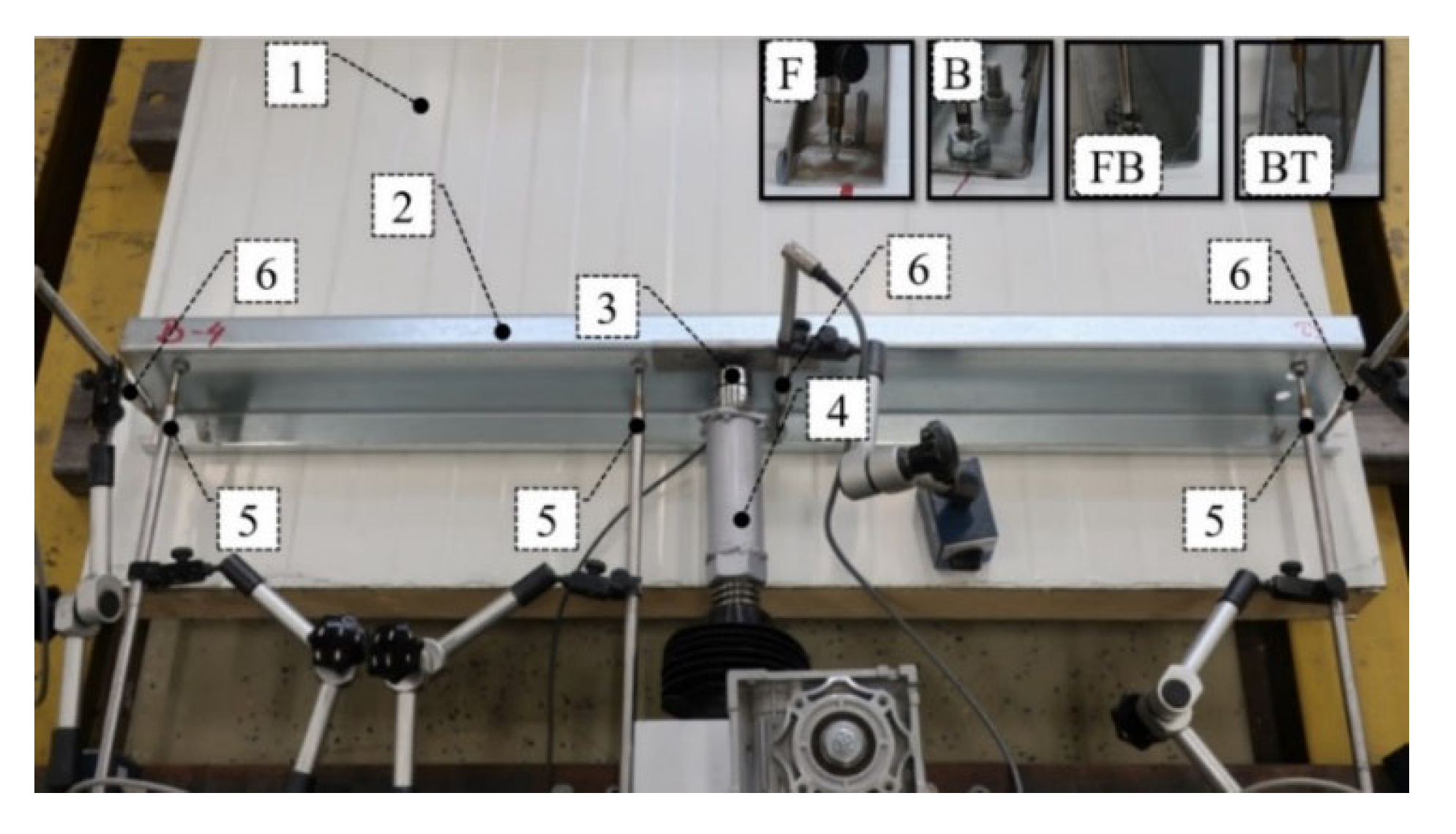
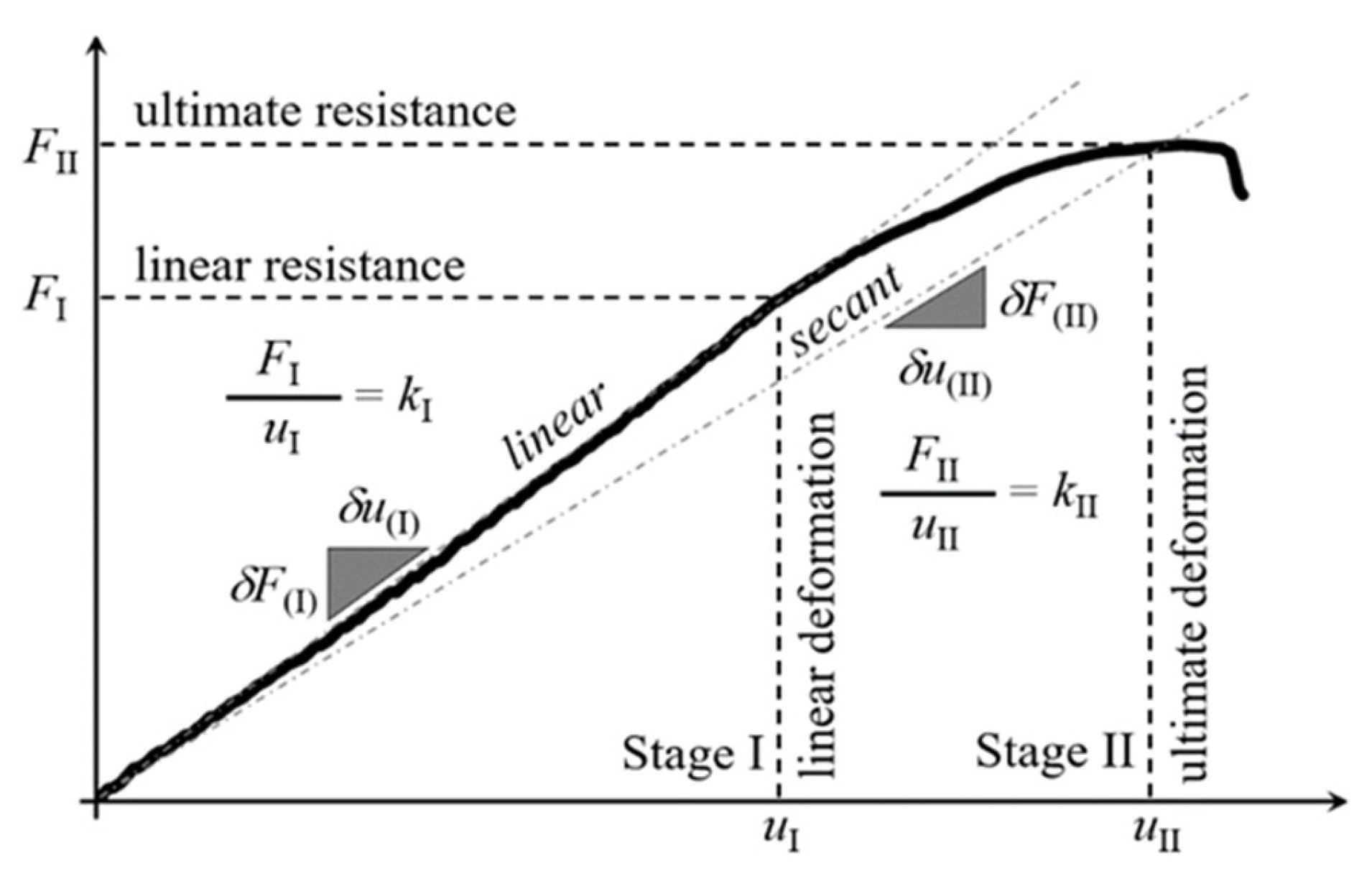
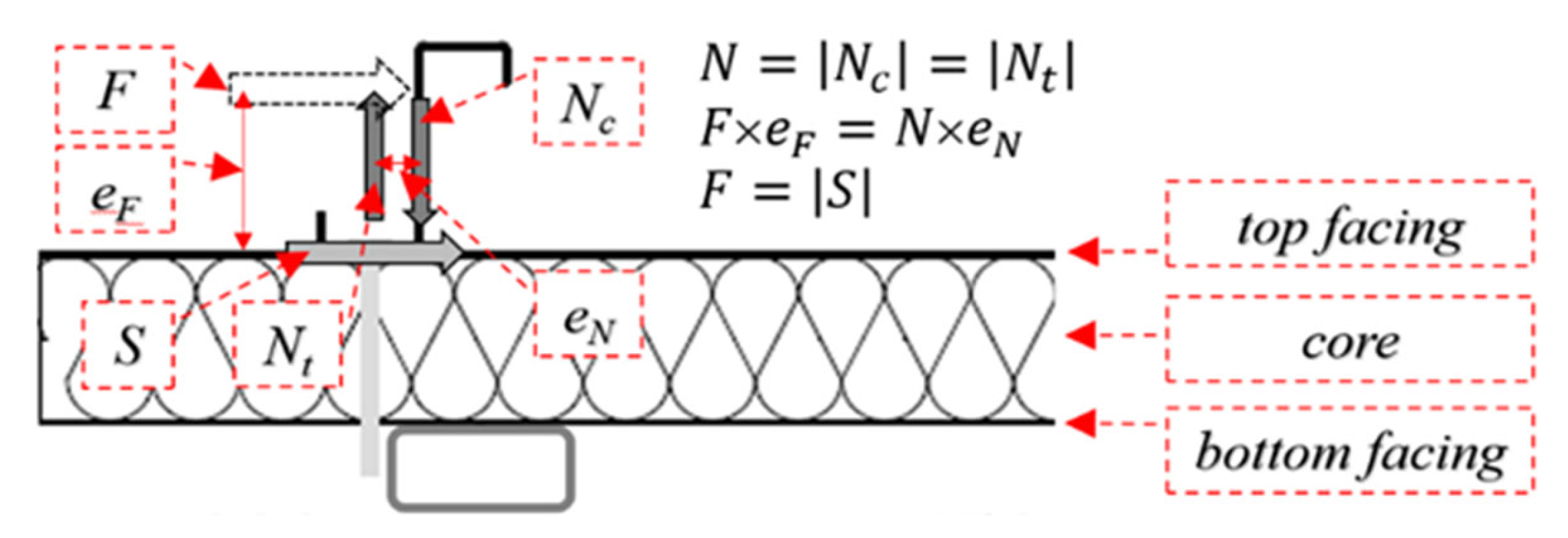
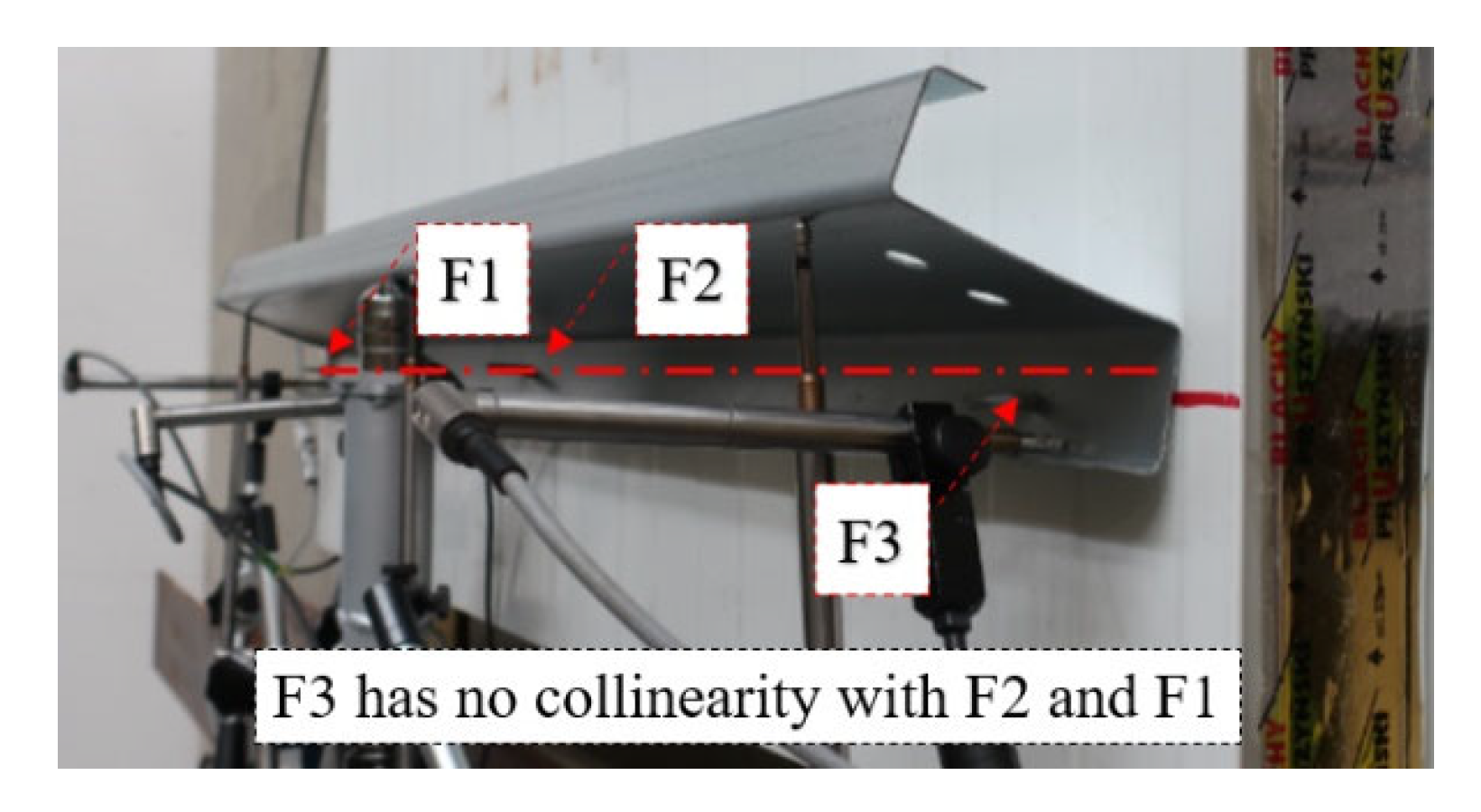
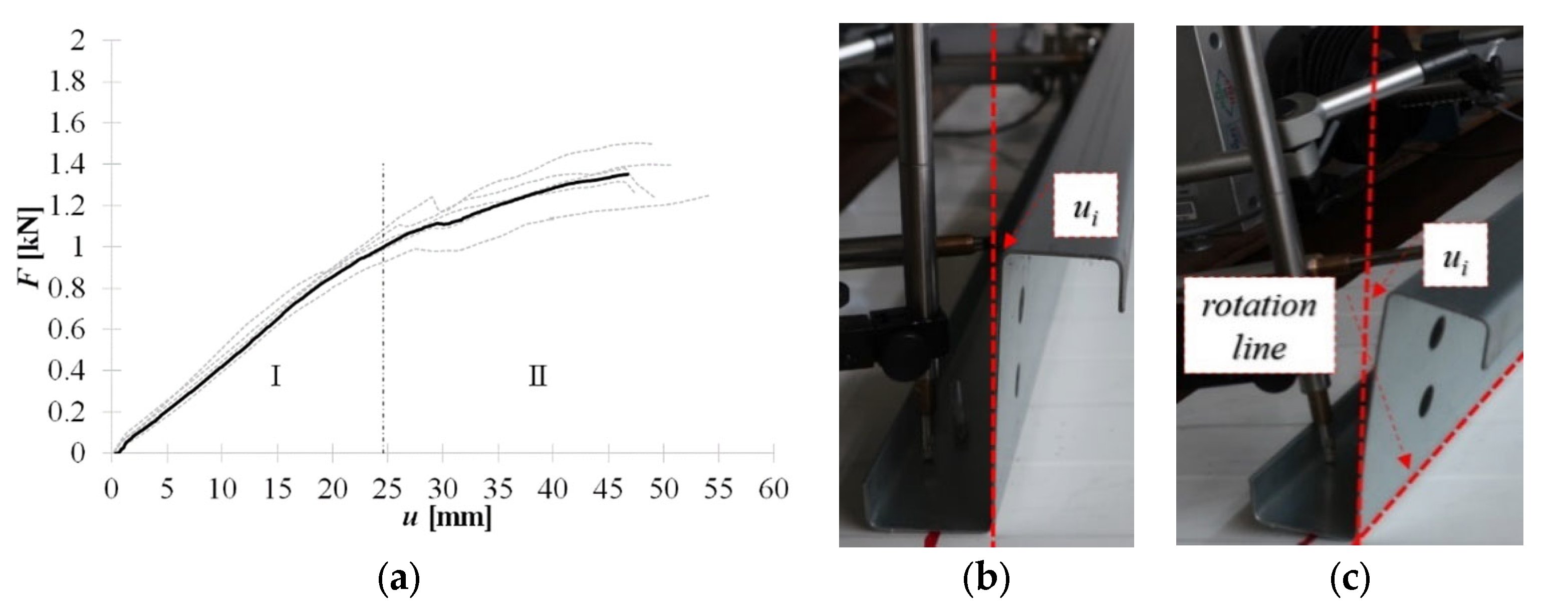

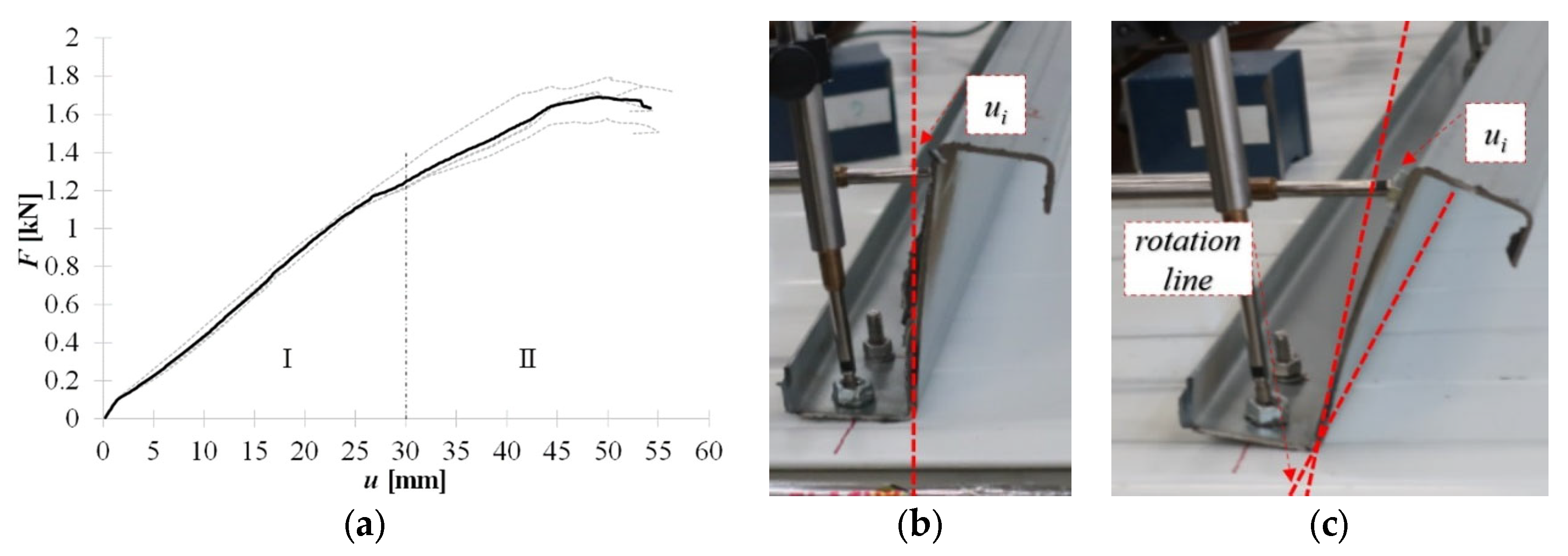
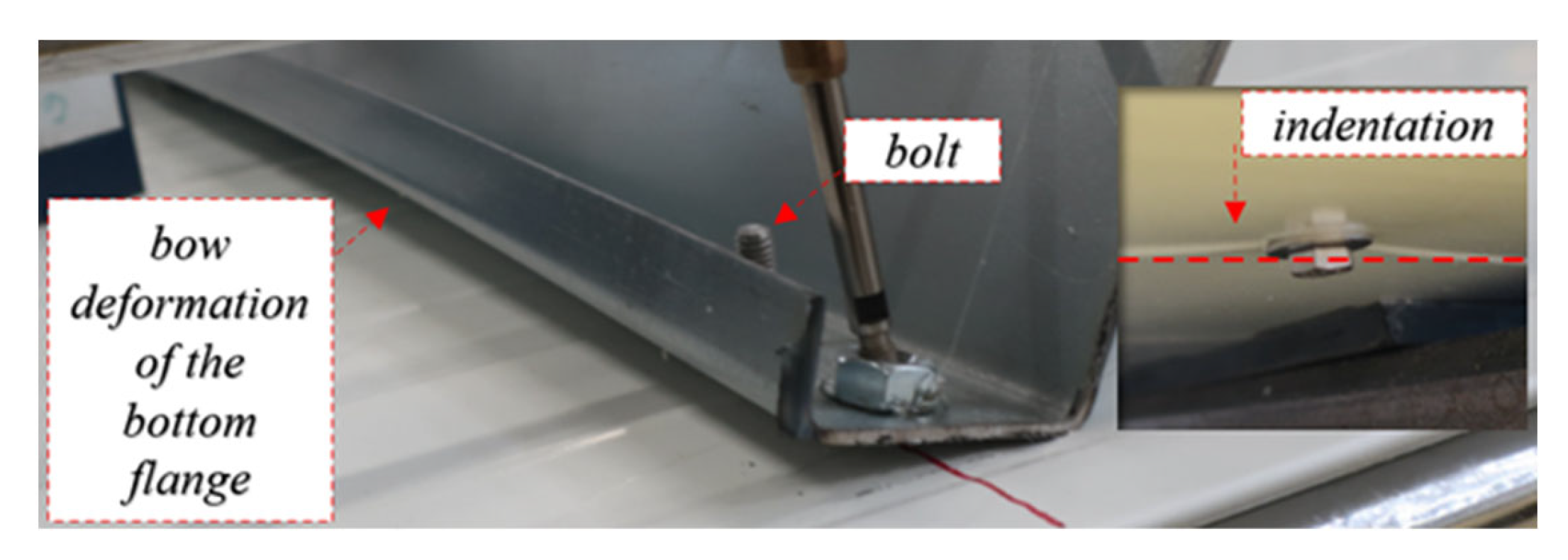
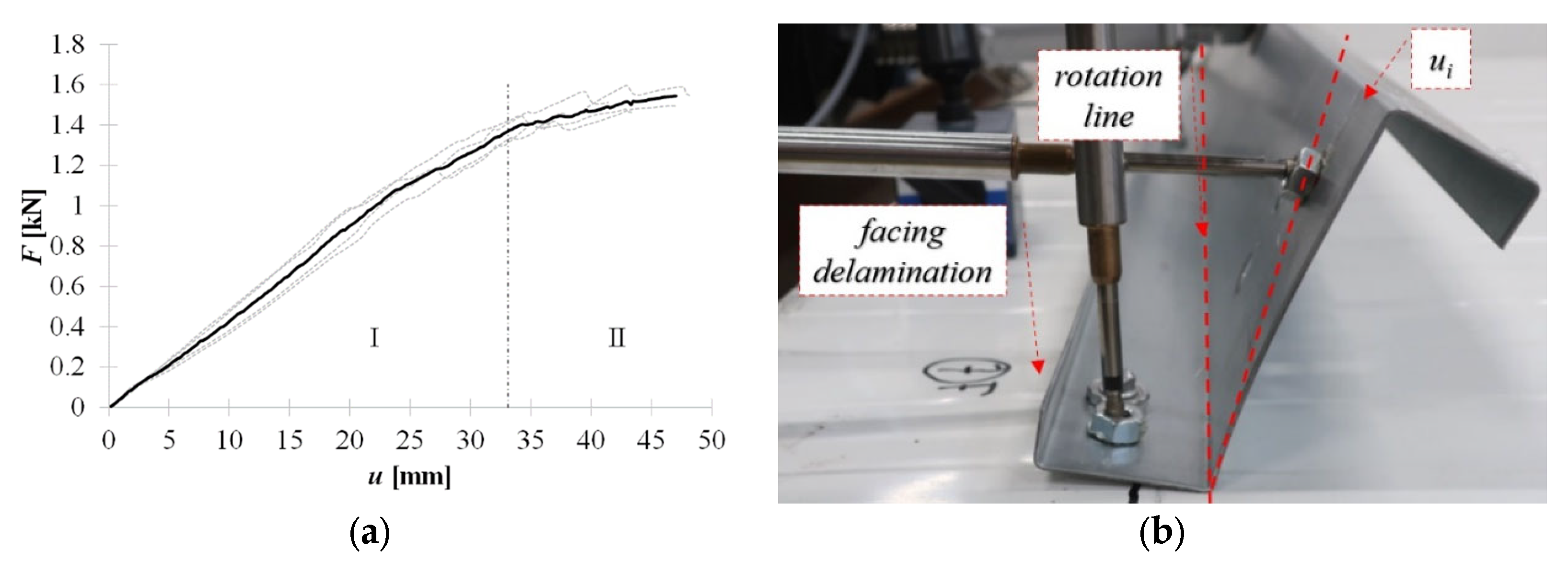
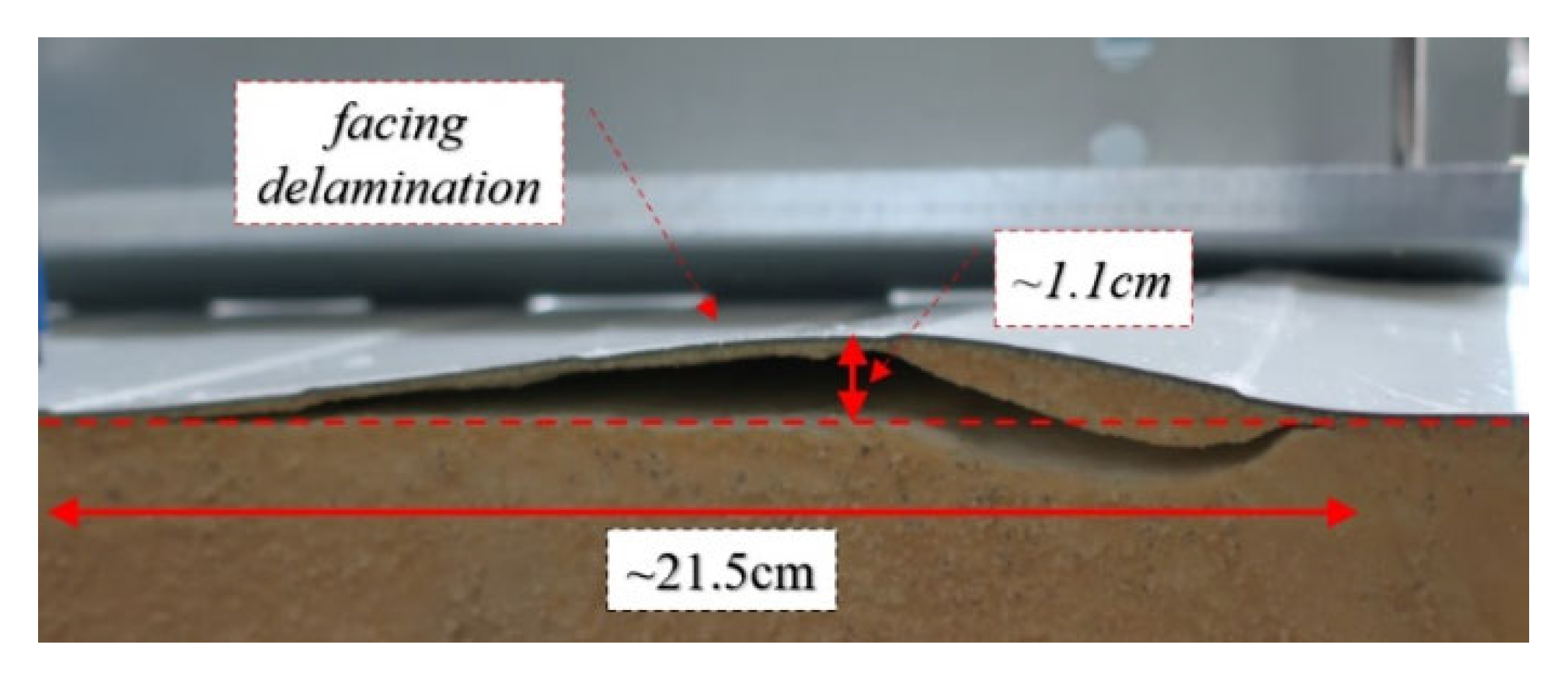

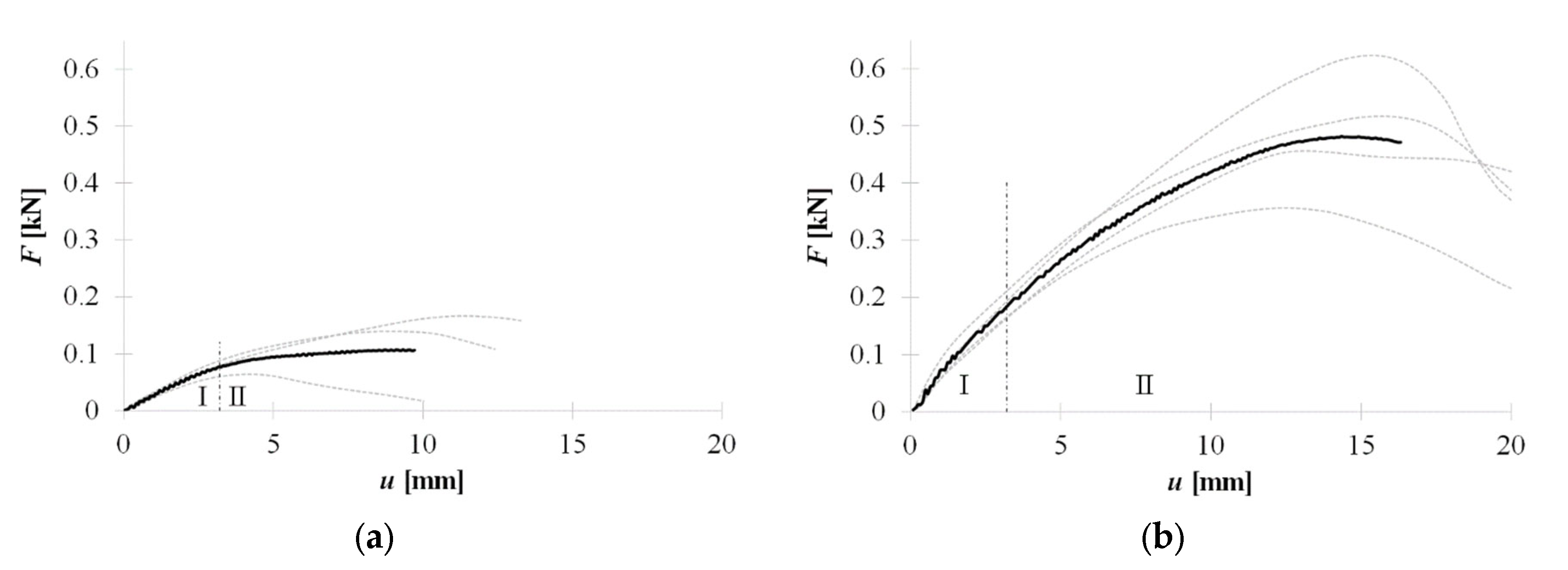
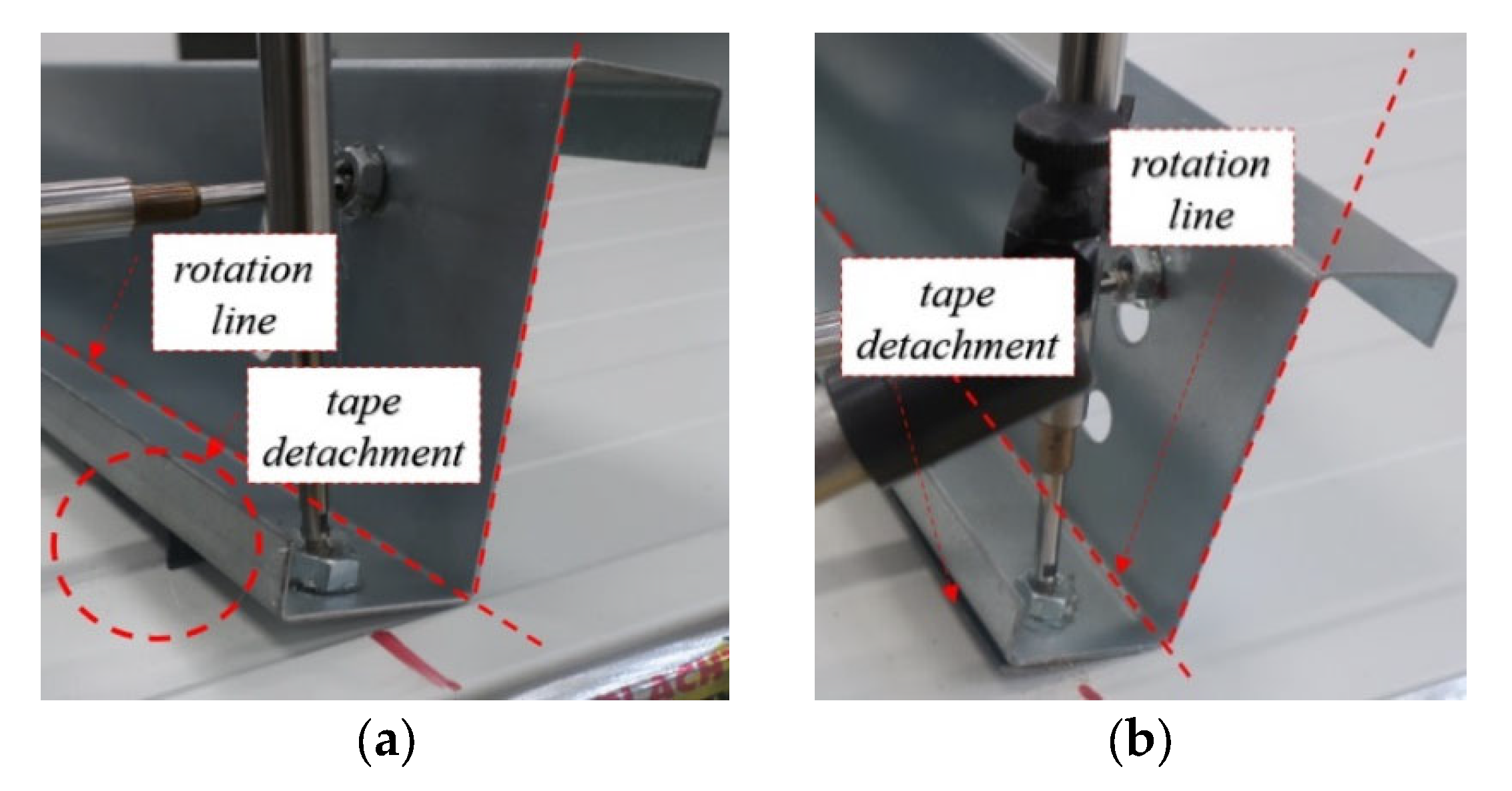
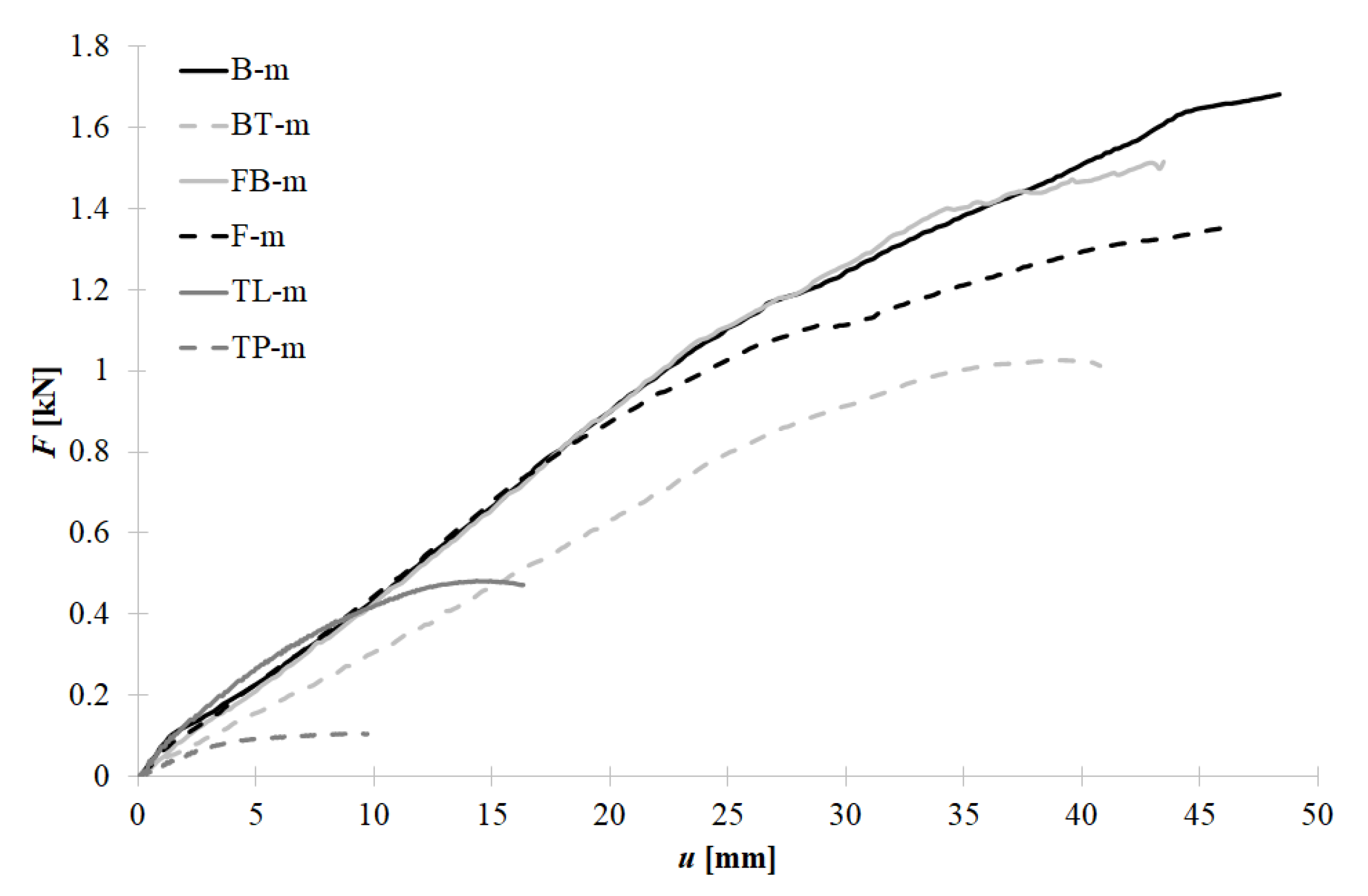

| Parameter | Unit | F | B | BT | FB | TL | TP |
|---|---|---|---|---|---|---|---|
| FI | [kN] | 1.02 ± 0.06 | 1.25 ± 0.06 | 0.95 ± 0.07 | 1.37 ± 0.05 | 0.18 ± 0.02 | 0.08 ± 0.01 |
| uI | [mm] | 24.63 ± 3.73 | 30.03 ± 1.44 | 32.08 ± 2.20 | 33.13 ± 1.83 | 3.20 ± 0.17 | 3.20 ± 0.07 |
| kI | [kN/m] | 41.3 | 41.6 | 29.9 | 41.3 | 57.5 | 23.9 |
| AI | [kNm] | 0.0135 | 0.0201 | 0.0161 | 0.0240 | 0.0003 | 0.0001 |
| FII | [kN] | 1.35 ± 0.09 | 1.68 ± 0.09 | 1.01 ± 0.07 | 1.52 ± 0.05 | 0.47 ± 0.12 | 0.11 ± 0.05 |
| uII | [mm] | 46.18 ± 3.64 | 48.16 ± 1.86 | 40.75 ± 0.80 | 43.47 ± 2.37 | 16.32 ± 2.00 | 9.72 ± 4.11 |
| kII | [kN/m] | 29.3 | 34.9 | 24.9 | 34.9 | 28.9 | 10.9 |
| AII | [kNm] | 0.0396 | 0.0471 | 0.0248 | 0.0390 | 0.0054 | 0.0008 |
| n | [–] | 5 | 4 | 4 | 4 | 4 | 3 |
Publisher’s Note: MDPI stays neutral with regard to jurisdictional claims in published maps and institutional affiliations. |
© 2022 by the authors. Licensee MDPI, Basel, Switzerland. This article is an open access article distributed under the terms and conditions of the Creative Commons Attribution (CC BY) license (https://creativecommons.org/licenses/by/4.0/).
Share and Cite
Ciesielczyk, K.; Studziński, R. Experimental Investigation of the Failure Scenario of Various Connection Types between Thin-Walled Beam and Sandwich Panel. Materials 2022, 15, 6277. https://doi.org/10.3390/ma15186277
Ciesielczyk K, Studziński R. Experimental Investigation of the Failure Scenario of Various Connection Types between Thin-Walled Beam and Sandwich Panel. Materials. 2022; 15(18):6277. https://doi.org/10.3390/ma15186277
Chicago/Turabian StyleCiesielczyk, Katarzyna, and Robert Studziński. 2022. "Experimental Investigation of the Failure Scenario of Various Connection Types between Thin-Walled Beam and Sandwich Panel" Materials 15, no. 18: 6277. https://doi.org/10.3390/ma15186277
APA StyleCiesielczyk, K., & Studziński, R. (2022). Experimental Investigation of the Failure Scenario of Various Connection Types between Thin-Walled Beam and Sandwich Panel. Materials, 15(18), 6277. https://doi.org/10.3390/ma15186277





